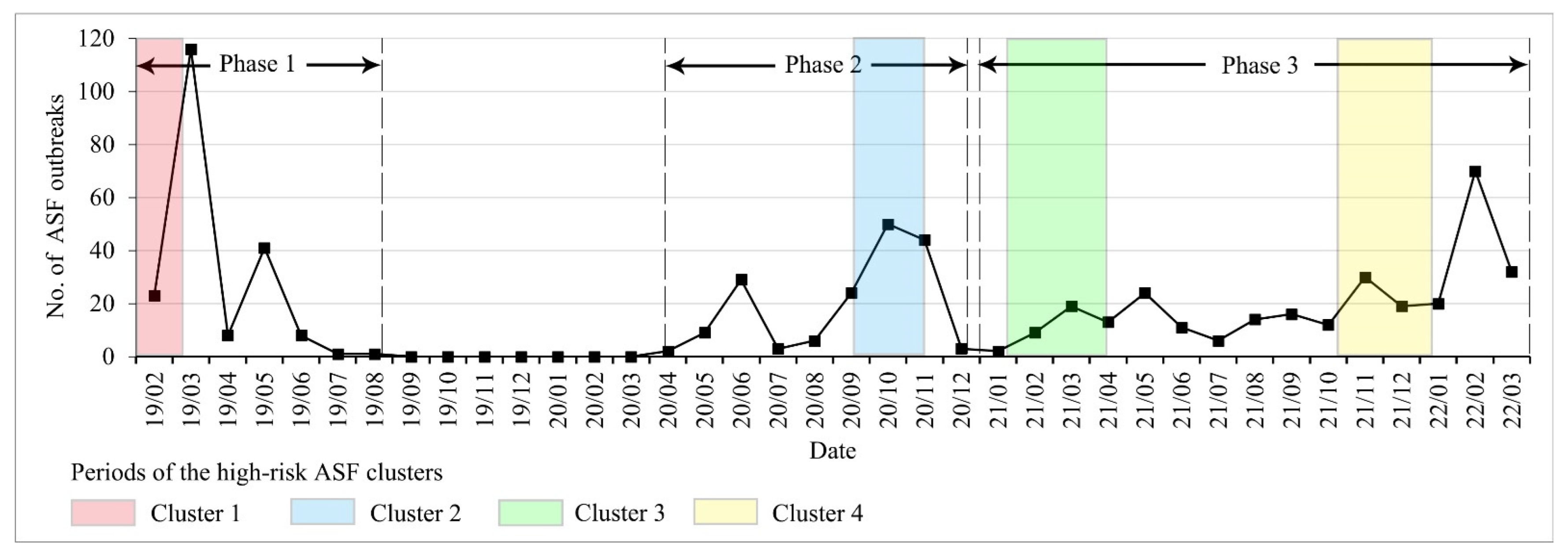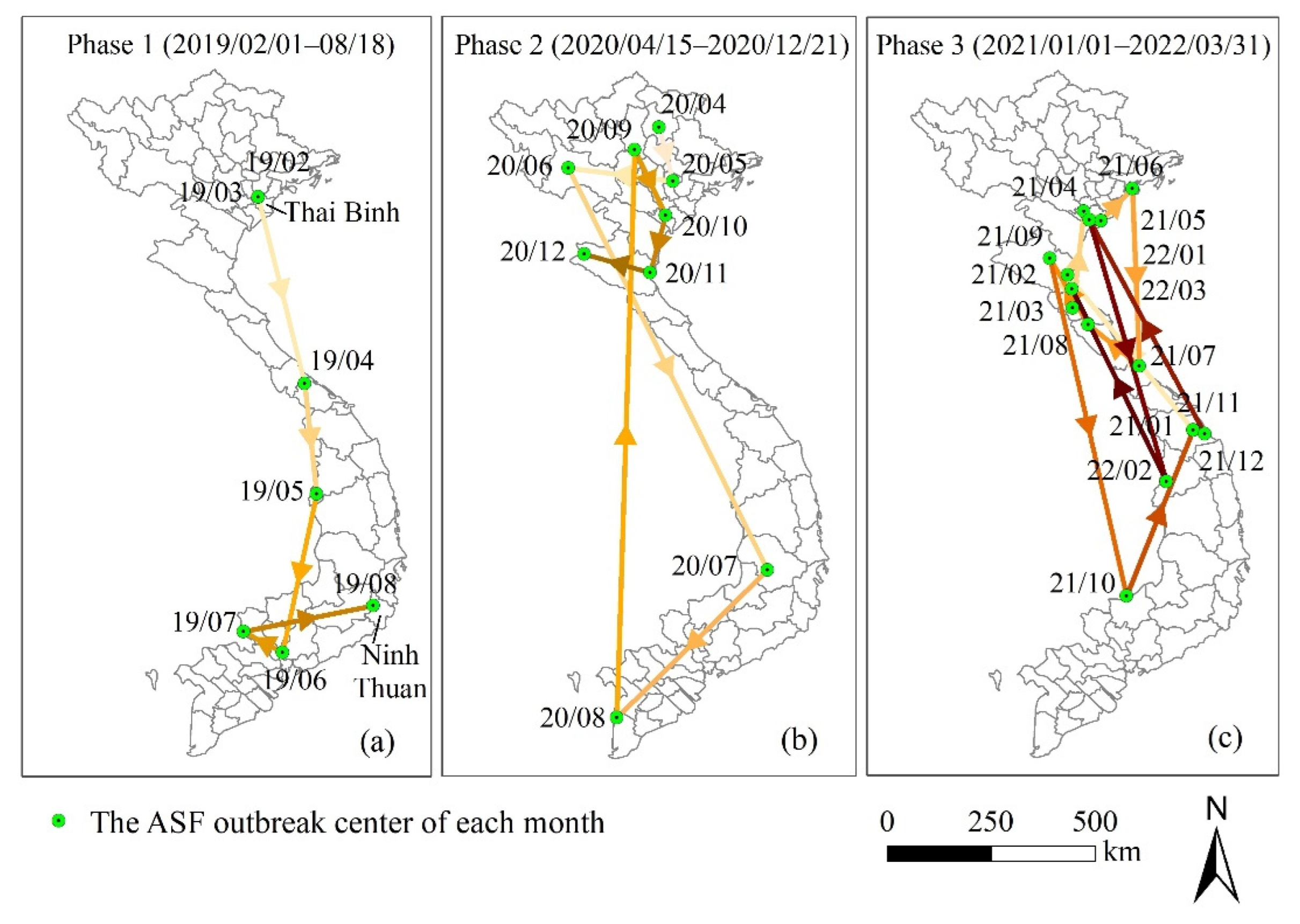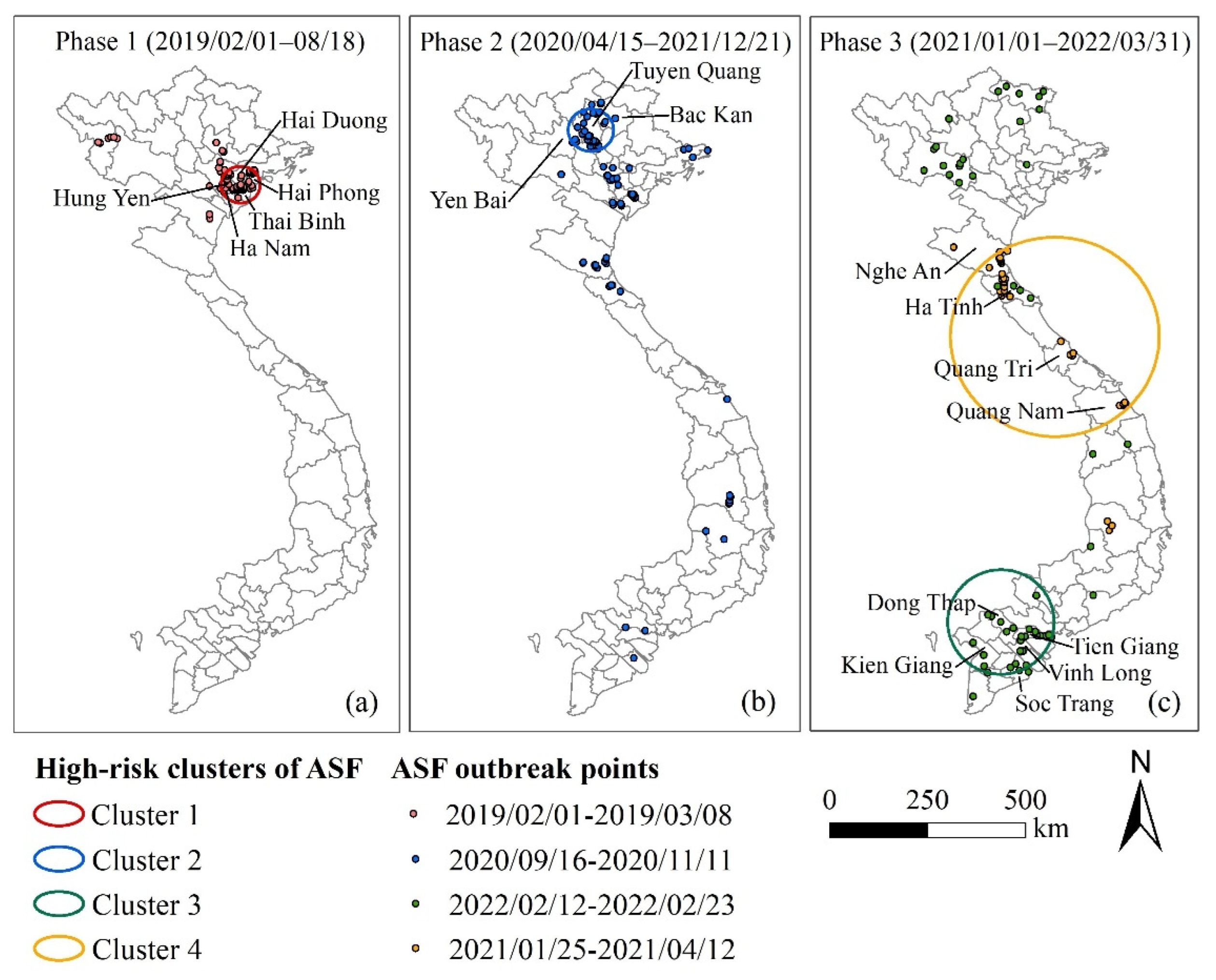Temporal and Spatial Evolution of the African Swine Fever Epidemic in Vietnam
Abstract
:1. Introduction
2. Materials and Methods
2.1. Data and Sources
2.2. Spatial Statistical Methods
2.2.1. Directional Analysis
2.2.2. Spatial Autocorrelation Analysis
2.2.3. Retrospective Spatiotemporal Scan Analysis
3. Results
3.1. The Situation of the ASF in Vietnam
3.2. The Directional Spreading of the ASF
3.3. Spatial Aggregation Characteristics of the ASF
3.3.1. Spatial Autocorrelation Results of the ASF
3.3.2. Spatiotemporal High-Risk Clusters
4. Discussion
4.1. Analysis of Temporal Characteristics of the ASF in Vietnam
4.2. Analysis of Spatiotemporal Characteristics of ASF in Vietnam
4.3. The Limitation of this Study
5. Conclusions
Author Contributions
Funding
Institutional Review Board Statement
Informed Consent Statement
Data Availability Statement
Acknowledgments
Conflicts of Interest
References
- Tulman, E.R.; Delhon, G.A.; Ku, B.K.; Rock, D.L. African Swine Fever Virus. Lesser Known Large Dsdna Viruses 2009, 328, 43–87. [Google Scholar]
- Costard, S.; Mur, L.; Lubroth, J.; Sanchez-Vizcaino, J.M.; Pfeiffer, D.U. Epidemiology of African swine fever virus. Virus Res. 2013, 173, 191–197. [Google Scholar] [CrossRef]
- Galindo, I.; Alonso, C. African Swine Fever Virus: A Review. Viruses 2017, 9, 103. [Google Scholar] [CrossRef] [Green Version]
- Chenais, E.; Depner, K.; Guberti, V.; Dietze, K.; Viltrop, A.; Ståhl, K. Epidemiological considerations on African swine fever in Europe 2014–2018. Porc. Health Manag. 2019, 5, 6. [Google Scholar] [CrossRef]
- WOAH. Terrestrial Animal Health Code. 2021. Available online: https://www.woah.org/en/what-we-do/standards/codes-and-manuals/terrestrial-code-online-access/?id=169&L=161&htmfile=sommaire.htm (accessed on 17 May 2022).
- Health, E.P.o.A.; Welfare. Scientific Opinion on African Swine Fever. EFSA J. 2010, 8, 1556. [Google Scholar] [CrossRef]
- Mazur-Panasiuk, N.; Zmudzki, J.; Wozniakowski, G. African swine fever virus—Persistence in different environmental conditions and the possibility of its indirect transmission. J. Vet. Res. 2019, 63, 303–310. [Google Scholar] [CrossRef] [Green Version]
- WOAH. African Swine Fever (ASF)—Situation Report 13. 2022. Available online: https://www.woah.org/en/disease/african-swine-fever/#ui-id-2 (accessed on 17 May 2022).
- Mur, L.; Martínez-López, B.; Sánchez-Vizcaíno, J.M. Risk of African swine fever introduction into the European Union through transport-associated routes: Returning trucks and waste from international ships and planes. BMC Vet. Res. 2012, 8, 149. [Google Scholar] [CrossRef] [Green Version]
- Dee, S.; Bauermann, F.; Niederwerder, M.; Singrey, A.; Clement, T.; Lima, M.; Long, C.; Patterson, G.; Sheahan, M.; Stoian, A.; et al. Survival of viral pathogens in animal feed ingredients under transboundary shipping models. PLoS ONE 2018, 13, e0194509. [Google Scholar] [CrossRef] [Green Version]
- Wilkinson, P.J.; Donaldson, A.I. Transmission studies with African swine fever virus—early distribution of virus in pigs infected by airborne virus. J. Comp. Pathol. 1977, 87, 497–501. [Google Scholar] [CrossRef]
- Plowright, W.; Parker, J.; Peirce, M.A. African Swine Fever Virus in Ticks (Ornithodoros moubata, Murray) collected from Animal Burrows in Tanzania. Nature 1969, 221, 1071–1073. [Google Scholar] [CrossRef]
- Mellor, P.S.; Kitching, R.P.; Wilkinson, P.J. Mechanical transmission of capripox virus and African swine fever virus by Stomoxys calcitrans. Res. Vet. Sci. 1987, 43, 109–112. [Google Scholar] [CrossRef]
- Gladue, D.P.; Borca, M.V. Recombinant ASF Live Attenuated Virus Strains as Experimental Vaccine Candidates. Viruses 2022, 14, 878. [Google Scholar] [CrossRef]
- Penrith, M.L. African swine fever. Onderstepoort J. Vet. Res. 2009, 76, 91–95. [Google Scholar] [CrossRef]
- Dixon, L.K.; Sun, H.; Roberts, H. African swine fever. Antivir. Res. 2019, 165, 34–41. [Google Scholar] [CrossRef]
- Le, V.P.; Jeong, D.G.; Yoon, S.-W.; Kwon, H.-M.; Trinh, T.B.N.; Nguyen, T.L.; Bui, T.T.N.; Oh, J.; Kim, J.B.; Cheong, K.M.; et al. Outbreak of African Swine Fever, Vietnam, 2019. Emerg. Infect. Dis. J. 2019, 25, 1433. [Google Scholar] [CrossRef]
- Mighell, E.; Ward, M.P. African Swine Fever spread across Asia, 2018-2019. Transbound. Emerg. Dis. 2021, 68, 2722–2732. [Google Scholar] [CrossRef]
- Chen, Z.; Wang, X.; Wang, Q. Spatio-temperal characteristics and influencing factors of African swine fever epidemic in China. Chin. J. Vet. Sci. 2020, 40, 12. [Google Scholar] [CrossRef]
- Kedkovid, R.; Sirisereewan, C.; Thanawongnuwech, R. Major swine viral diseases: An Asian perspective after the African swine fever introduction. Porc. Health Manag. 2020, 6, 20. [Google Scholar] [CrossRef]
- Nguyen-Thi, T.; Pham-Thi-Ngoc, L.; Nguyen-Ngoc, Q.; Dang-Xuan, S.; Lee, H.S.; Nguyen-Viet, H.; Padungtod, P.; Nguyen-Thu, T.; Nguyen-Thi, T.; Tran-Cong, T.; et al. An Assessment of the Economic Impacts of the 2019 African Swine Fever Outbreaks in Vietnam. Front. Vet. Sci. 2021, 8, 686038. [Google Scholar] [CrossRef]
- Reuters. African swine fever outbreak spreading widely in Vietnam. In Healthcare & Pharmaceuticals; Petty, M., Ed.; Reuters: London, UK, 2021; Available online: https://www.reuters.com/business/healthcare-pharmaceuticals/african-swine-fever-outbreak-spreading-widely-vietnam-government-2021-2011-2025/ (accessed on 12 May 2022).
- Nga, B.T.T.; Tran Anh Dao, B.; Nguyen Thi, L.; Osaki, M.; Kawashima, K.; Song, D.; Salguero, F.J.; Le, V.P. Clinical and Pathological Study of the First Outbreak Cases of African Swine Fever in Vietnam, 2019. Front. Vet. Sci. 2020, 7, 392. [Google Scholar] [CrossRef]
- Perez, A.; Alkhamis, M.; Carlsson, U.; Brito, B.; Carrasco-Medanic, R.; Whedbee, Z.; Willeberg, P. Global animal disease surveillance. Spat. Spatio-Temporal Epidemiol. 2011, 2, 135–145. [Google Scholar] [CrossRef]
- Qiu, J.; Li, R.D.; Xu, X.J.; Hong, X.C.; Xia, X.; Yu, C.H. Spatiotemporal pattern and risk factors of the reported novel avian-origin influenza A(H7N9) cases in China. Prev. Vet. Med. 2014, 115, 229–237. [Google Scholar] [CrossRef]
- Franch-Pardo, I.; Napoletano, B.M.; Rosete-Verges, F.; Billa, L. Spatial analysis and GIS in the study of COVID-19. A review. Sci. Total Environ. 2020, 739, 140033. [Google Scholar] [CrossRef]
- Zakharova, O.I.; Titov, I.A.; Gogin, A.E.; Sevskikh, T.A.; Korennoy, F.I.; Kolbasov, D.V.; Abrahamyan, L.; Blokhin, A.A. African Swine Fever in the Russian Far East (2019–2020): Spatio-Temporal Analysis and Implications for Wild Ungulates. Front. Vet. Sci. 2021, 8, 723081. [Google Scholar] [CrossRef]
- Qiu, J.; Li, R.; Xiao, Y.; Xia, J.; Zhu, H.; Niu, Y.; Huang, D.; Shao, Q.; Cui, Y.; Wang, Y. Spatiotemporal Heterogeneity in Human Schistosoma japonicum Infection at Village Level in Hubei Province, China. Int. J. Environ. Res. Public Health 2019, 16, 2198. [Google Scholar] [CrossRef] [Green Version]
- He, W.; Wang, L.-Y.; Yu, W.-J.; Zhang, G.-J.; Zhong, B.; Liao, S.; Wang, Q.; Li, R.-R.; Yang, L.; Yao, R.-X.; et al. Prevalence and spatial distribution patterns of human echinococcosis at the township level in Sichuan Province, China. Infect. Dis. Poverty 2021, 10, 82. [Google Scholar] [CrossRef]
- Kulldorff, M.; Heffernan, R.; Hartman, J.; Assunção, R.; Mostashari, F. A space-time permutation scan statistic for disease outbreak detection. PLoS Med. 2005, 2, 216–224. [Google Scholar] [CrossRef] [Green Version]
- Lu, Y.; Deng, X.; Chen, J.; Wang, J.; Chen, Q.; Niu, B. Risk analysis of African swine fever in Poland based on spatio-temporal pattern and Latin hypercube sampling, 2014–2017. BMC Vet. Res. 2019, 15, 160. [Google Scholar] [CrossRef]
- Wang, L.; Quzhen, G.; Qin, M.; Liu, Z.; Pang, H.; Frutos, R.; Gavotte, L. Geographic distribution and prevalence of human echinococcosis at the township level in the Tibet Autonomous Region. Infect. Dis. Poverty 2022, 11, 10. [Google Scholar] [CrossRef]
- Lee, H.S.; Dao, T.D.; Huyen, L.T.T.; Bui, V.N.; Bui, A.N.; Ngo, D.T.; Pham, U.B. Spatiotemporal Analysis and Assessment of Risk Factors in Transmission of African Swine Fever Along the Major Pig Value Chain in Lao Cai Province, Vietnam. Front. Vet. Sci. 2022, 9, 853825. [Google Scholar] [CrossRef]
- FAO. EMPRES-i (Global Animal Disease Information System). 2022. Available online: https://empres-i.apps.fao.org/ (accessed on 17 May 2022).
- John, M. A Dictionary of Epidemiology, 4th ed.; Oxford U Press: New York, NY, USA, 2001. [Google Scholar]
- General Statistics Office. Statistical Yearbook of Viet Nam 2019; Statistical Publishing House: Cau Giay, Ha Noi, Vietnam, 2020.
- General Statistics Office. Statistical Yearbook of Viet Nam 2020; Statistical Publishing House: Cau Giay, Ha Noi, Vietnam, 2021.
- Esri Products. ArcGIS. 2022. Available online: https://www.esri.com/en-us/arcgis/products/index (accessed on 30 September 2021).
- BioMedware. ClusterSeer. Ann Arbor, MI, USA. 2022. Available online: https://biomedware.com/products/clusterseer/ (accessed on 12 April 2022).
- Darand, M.; Dostkamyan, M.; Rehmanic, M.I.A. Spatial Autocorrelation Analysis of Extreme Precipitation in Iran. Russ. Meteorol. Hydrol. 2017, 42, 415–424. [Google Scholar] [CrossRef]
- Anselin, L. Local Indicators of Spatial Association—LISA. Geogr. Anal. 1995, 27, 93–115. [Google Scholar] [CrossRef]
- Mitchell, A. The ESRI Guide to GIS Analysis, Volume 2: Spatial Measurements and Statistics; ESRI Press: Redlands, CA, USA, 2005; Volume 2. [Google Scholar]
- Kulldorff, M.; Information Management Services. SaTScan v9.6: Software for the Spatial and Space-Time Scan Statistics. 2022. Available online: https://www.satscan.org (accessed on 27 September 2020).
- Iglesias, I.; Muñoz, M.J.; Montes, F.; Perez, A.; Gogin, A.; Kolbasov, D.; de la Torre, A. Reproductive Ratio for the Local Spread of African Swine Fever in Wild Boars in the Russian Federation. Transbound. Emerg. Dis. 2016, 63, e237–e245. [Google Scholar] [CrossRef]
- Iglesias, I.; Rodriguez, A.; Feliziani, F.; Rolesu, S.; de la Torre, A. Spatio-temporal Analysis of African Swine Fever in Sardinia (2012-2014): Trends in Domestic Pigs and Wild Boar. Transbound. Emerg. Dis. 2017, 64, 656–662. [Google Scholar] [CrossRef]
- Long, N.V. African Swine Fever in Vietnam-Lessons Learnt. Tokyo. 2020. Available online: https://www.maff.go.jp/j/syouan/douei/asf/attach/pdf/kaigi-23.pdf (accessed on 17 May 2022).
- Qui, N.H.; Guntoro, B.; Syahlani, S.P.; Linh, N.T. Factor Affecting the Information Sources and Communication Channels toward Pig Farmer’s Perception of African Swine Fever in Tra Vinh Province, Vietnam. Trop. Anim. Sci. J. 2021, 44, 248–254. [Google Scholar] [CrossRef]
- FAO. ASF Situation in Asia & Pacific Update. 2022. Available online: https://www.fao.org/ag/againfo/programmes/en/empres/ASF/situation_update.html (accessed on 17 May 2022).
- Journal, V.B. About to Announce African Swine Fever Vaccine Researched by Vietnamese Enterprises. 2022. Available online: https://doanhnghiepvn.vn/cong-nghe/sap-cong-bo-vaccine-dich-ta-lon-chau-phi-do-doanh-nghiep-viet-nghien-cuu/20220418083912184 (accessed on 17 May 2022).
- MARD. Official Letter (No.1199/BNN-TY). 2022. Available online: https://cucthuy.gov.vn/documents/20125/20120/220302_221199_CV_ThangVSDTKT.pdf (accessed on 17 May 2022).
- Shi, G.; Zhang, T.; Wang, W. Spatio-temporal evolution characteristics and causes of African swine fever in China. J. Arid. Land Resour. Environ. 2020, 34, 137–142. [Google Scholar] [CrossRef]
- WOAH. ASF Situation in Viet Nam. Hanoi. 2021. Available online: https://rr-asia.woah.org/wp-content/uploads/2021/04/8_vietnam_long.pdf (accessed on 17 May 2022).
- Sanchez-Vizcaino, J.M.; Mur, L.; Gomez-Villamandos, J.C.; Carrasco, L. An Update on the Epidemiology and Pathology of African Swine Fever. J. Comp. Pathol. 2015, 152, 9–21. [Google Scholar] [CrossRef]
- Leray, L.S.G.; Ward, M.P. Web-scraping applied to acquire difficult to access animal disease outbreak information, using African Swine Fever in Europe as an example. Transbound. Emerg. Dis. 2021, 68, 2795–2805. [Google Scholar] [CrossRef]
- Horigan, V.; de Nardi, M.; Crescio, M.I.; Estrada-Pena, A.; Adkin, A.; Maurella, C.; Bertolini, S.; Leger, A.; Ru, G.; Cook, C.; et al. Maximising data to optimise animal disease early warning systems and risk assessment tools within Europe. Microb. Risk Anal. 2019, 13, 100072. [Google Scholar] [CrossRef] [Green Version]
- Zhang, Z.J.; Chen, D.M.; Chen, Y.; Liu, W.B.; Wang, L.; Zhao, F.; Yao, B.D. Spatio-Temporal Data Comparisons for Global Highly Pathogenic Avian Influenza (HPAI) H5N1 Outbreaks. PLoS ONE 2010, 5, e15314. [Google Scholar] [CrossRef] [Green Version]





| Method | Data | Time Scale | Space Scale | The Revealed Spatiotemporal Characteristics | |
|---|---|---|---|---|---|
| Direction analysis | Outbreak centers | Month | Outbreaks | Diffusion direction | |
| Spatial autocorrelation analysis | Global Moran’s I | Occurrence rate | Phase | Province | Spatial distribution pattern (clustered, dispersed, or random) |
| Anselin Local Moran’s I | Clusters or outliers | ||||
| Retrospective spatiotemporal scan analysis | Outbreaks | Day | Outbreaks | Spatiotemporal high clusters | |
| Phase | Date | No. of Central Points | Direction Test Result | ||
|---|---|---|---|---|---|
| Average Angle (°) * | Concentration | p-Value | |||
| 1 | February 2019–August 2019 | 7 | 278.51 | 0.74 | 0.001 |
| 2 | April 2020–December 2020 | 9 | 264.85 | 0.35 | 0.001 |
| 3 | January 2021–March 2022 | 15 | 288.56 | 0.18 | 0.001 |
| Phase | Date | Global Moran’s I | |||
|---|---|---|---|---|---|
| I | z-Score | p-Value | Distribution Pattern | ||
| 1 | February 2019–August 2019 | 0.47 | 8.14 | <0.01 | Aggregated |
| 2 | April 2020–December 2020 | 0.05 | 0.1.05 | 0.29 | Random |
| 3 | January 2021–March 2022 | −0.06 | −0.58 | 0.56 | Random |
| Cluster | Date | Duration (Days) | Cluster Center Location | Radius (km) | Observed Points | Expected Points | RR 1 | LLR 2 | p-Value |
|---|---|---|---|---|---|---|---|---|---|
| 1 | 1 January 2019–8 March 2019 | 36 | 20.676 N, 106.357 E | 46.76 | 79 | 14.44 | 5.47 | 73.01 | <0.01 |
| 2 | 16 September 2020–11 November 2020 | 58 | 21.972 N, 105.266 E | 53.68 | 31 | 5.12 | 6.06 | 30.47 | <0.01 |
| 3 | 12–23 February 2022 | 12 | 10.668 N, 105.561 E | 133.07 | 26 | 3.91 | 6.65 | 27.54 | <0.01 |
| 4 | 25 January 2021–12 April 2021 | 76 | 17.204 N, 106.798 E | 254.01 | 29 | 5.41 | 5.36 | 25.53 | <0.01 |
Publisher’s Note: MDPI stays neutral with regard to jurisdictional claims in published maps and institutional affiliations. |
© 2022 by the authors. Licensee MDPI, Basel, Switzerland. This article is an open access article distributed under the terms and conditions of the Creative Commons Attribution (CC BY) license (https://creativecommons.org/licenses/by/4.0/).
Share and Cite
Shao, Q.; Li, R.; Han, Y.; Han, D.; Qiu, J. Temporal and Spatial Evolution of the African Swine Fever Epidemic in Vietnam. Int. J. Environ. Res. Public Health 2022, 19, 8001. https://doi.org/10.3390/ijerph19138001
Shao Q, Li R, Han Y, Han D, Qiu J. Temporal and Spatial Evolution of the African Swine Fever Epidemic in Vietnam. International Journal of Environmental Research and Public Health. 2022; 19(13):8001. https://doi.org/10.3390/ijerph19138001
Chicago/Turabian StyleShao, Qihui, Rendong Li, Yifei Han, Dongfeng Han, and Juan Qiu. 2022. "Temporal and Spatial Evolution of the African Swine Fever Epidemic in Vietnam" International Journal of Environmental Research and Public Health 19, no. 13: 8001. https://doi.org/10.3390/ijerph19138001
APA StyleShao, Q., Li, R., Han, Y., Han, D., & Qiu, J. (2022). Temporal and Spatial Evolution of the African Swine Fever Epidemic in Vietnam. International Journal of Environmental Research and Public Health, 19(13), 8001. https://doi.org/10.3390/ijerph19138001







